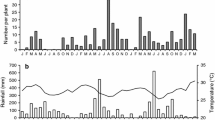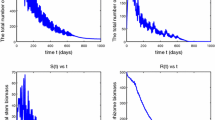Summary
-
1.
A mathematical model was constructed describing population dynamics of the arrowhead scale,Unaspis yanonensis Kuwana. The population occurrence patterns simulated by the model from 1971 to 1976 were relatively consistent with the actual findings in the field.
-
2.
The effects of control tactics for this pest were examined on the basis of the model.
-
3.
Effective timing of insecticide (petroleum oil and organophosphorous insecticide) application was indicated to be 40 days after the initial appearance of 1st-instar nymphs in both the 1st and 2nd generations of the host.
-
4.
The number of overwintering adult females in May of the next year (i.e., the starting point of the next year’s population) decreased linearly with the increment in the degree of insecticide coverage. The pest populations were expected to be kept to low densities by petroleum oil sprays alone for the 1st generation when overall, complete coverage was accomplished.
-
5.
Examination of the effects of two introduced parasitoids,Aphytis yanonensis andCoccobius fulvus, showed that they were able to control the scale population by themselves when more than 70% parasitism was achieved. When petroleum oil was applied to overwintering adults (termed winter petroleum oil) at the degree of coverage of 0.8, host populations were reduced by ca. 60% parasitism. When the winter petroleum oil was combined either with additional petroleum oil 40 days after the initial appearance of 1st-instar nymphs of the 1st generation or with an organophosphorous insecticide 40 days after the initial appearance of 1st-instar nymphs of the 2nd generation (degree of coverage=0.8 in each case), 40% parasitism led the reduction of the pest population.
-
6.
The most desirable control program was considered to be one in which winter petroleum oil was used every year and additional petroleum oil or an organophosphorous insecticide was also used in those years when host density was high.
Similar content being viewed by others
References
Adachi, I. and R. Korenaga (1991) Fertility schedules ofUnaspis yanonensis (Hymenoptera: Diaspididae) in relation to daily temperature.Res. Popul. Ecol. 33: 57–68.
Carman. G. E. (1989) Chemical control of insects and mites on citrus. 89–177. In W. Reuther, E. C. Calavan and G. E. Carman (ed)The Citrus Industry, Volume 5. The Regents of the University of California, Division of Agriculture and Natural Resources.
Chi, H. (1990) Timing of control based on the stage structure of pest populations: a simulation approach.J. Econ. Entomol. 83: 1143–1150.
Coulson, R. N. and M. C. Saunders (1987) Computer-assisted decision-making as applied to entomology.Ann. Rev. Entomol. 32: 415–437.
Curry, G. L., P. J. H. Sharpe and E. W. DeMichele (1980) Towards a management model of the cotton-boll weevil ecosystem.J. Environ. Manag. 11: 187–223.
Furuhashi, K. and M. Nishino (1983) Biological control of arrowhead scale,Unaspis yanonensis by parasitic wasps introduced from the People’s Republic of China.Entomophaga 28: 277–286.
Hashimoto, S., K. Miyaji, Y. Gyoutoku, Y. Watanabe, I. Kai, I. Tamura, T. Ujiye and T. Kashio (1988) Dispersion ofAphytis yanonensis andCoccobius fulvus, introduced parasitoids of arrowhead scale,Unaspis yanonensis in Kyushu in 1987. II. Southern part of Kyushu.Proc. Assoc. Pl. Prot. Kyushu 34: 169–175. (In Japanese)
Hassell, M. P. (1976) Arthropod predator-prey systems. 71–93. In R. M. May (ed)Theoretical Ecology: Principles and Applications. Blackwell, Oxford.
Hutchins, S. H., L. G. Higley and L. P. Pedigo (1988) Injury equivalency as a basis for developing multiple-species economic injury levels.J. Econ. Entomol. 81: 1–8.
Inoue, T. and R. Ohgushi (1976) A simulation model of the arrowhead scale population on a citrus tree in relation to control programs (I).Res. Popul. Ecol. 18: 89–104.
Inoue, T. and R. Ohgushi (1977) A simulation model of the arrowhead scale population on a citrus tree in relation to control programs (II). Dispersal of the scale and the amount of petroleum oil.Res. Popul. Ecol. 19: 302–318.
Kawamoto, H., T. Saito and K. Kiritani (1986) A soybean growth model based on compensatory growth following defoliation.Ecol. Res. 1: 195–206.
Korenaga, R., Y. Sakagami and S. Okudai (1976) The effect of temperature on the development of the arrowhead scale,Unaspis yanonensis Kuwana II. Development of the first generation under fluctuating temperature.Bull. Fruit Tree Res. Stn. B 3: 47–56. (In Japanese with English summary)
Korenaga, R., Y. Sakagami and S. Komazaki (1980) Effect of temperature on the development of the arrowhead scale,Unaspis yanonensis Kuwana III. Development of the second generation under constant and fluctuating temperature.Bull. Fruit Tree Res. Stn. B 7: 99–108. (In Japanese with English summary)
Ludwig, D., D. D. Jones and C. S. Holling (1978) Qualitative analysis of insect outbreak systems: the spruce budworm and forest.J. Anim. Ecol. 47: 315–332.
Nishino, M. (1974) Studies on biology and forecasting of occurrence of the arrowhead scale,Unaspis yanonensis Kuwana.Special Bulletin of Shizuoka Prefectural Citrus Experiment Station 2: 1–101. (In Japanese with English summary)
Nishino, M. and K. Takagi (1981) Parasites of arrowhead scale,Unaspis yanonensis Kuwana, introduced from the People’s Republic of China.Plant Protection 35: 253–256. (In Japanese)
Norton, G. A., R. W. Sutherst and T. T. Maywald (1983) A framework for integrating control methods against the cattle tick,Boophilus microplus in Australia.J. Appl. Ecol. 20: 489–505.
Ohkubo, N. (1977) Deposition of machine oil on leaves of citrus and control of arrowhead scale,Unaspis yanonensis Kuwana.Kyushu Agricultural Research 39: 78–79. (In Japanese)
Ohkubo, N. (1978) Control threshold of the arrowhead scaleUnaspis yanonensis Kuwana.Plant Protection 32: 341–345. (In Japanese)
Ohkubo, N., F. Kuchiki, T. Tsutsumi, Y. Gyoutoku, T. Ujiye and T. Kashio (1988) Dispersion ofAphytis yanonensis andCoccobius fulvus, introduced parasitoids of arrowhead scale,Unaspis yanonensis in Kyushu in 1987. I. Northern part of Kyushu.Proc. Assoc. Pl. Prot. Kyushu 34: 161–168. (In Japanese)
Okudai, S. and R. Korenaga (1965) On the hibernation of the arrowhead scale,Unaspis yanonensis.Bull. Hort. Res. Sta., Japan, Ser. B 4: 159–198. (In Japanese with English summary)
Okudai, S., R. Korenaga and Y. Sakagami (1969) Studies on the seasonal appearance of each stage of the arrowhead scale,Unaspis yanonensis.Bull. Hort. Res. Sta., Japan, Ser. B 9: 199–220. (In Japanese with English summary)
Okudai, S., R. Korenaga and Y. Sakagami (1974) Studies on the autumnal appearance of larvae of the arrowhead scale,Unaspis yanonensis Kuwana II. On the relationship between temperature in the early stage of the autumn adults and the autumnal appearance of larvae.Bull. Fruit Tree Res. Stn. B 1: 101–113. (In Japanese with English summary)
Ruesink, W.G. (1982) Analysis and modeling in pest management. 353–378. In R. L. Metcalf and W. H. Luckmann (ed)Introduction to Insect Pest Management. Wiley, New York.
Ruppel, R. F. (1984) Model for effective timing of an insecticide.J. Econ. Entomol. 77: 1083–1085.
Rykiel, E. J., M. C. Saunders, T. L. Wagner, E. K. Loh, R. H. Turnbow, L. C. Hu, P. E. Pulley and R. N. Coulson (1984) Computer-aided decision making and information accessing in pest management systems, with emphasis on the southern pine beetle (Coleoptera: Scolytidae).J. Econ. Entomol. 77: 1073–1082.
Sakagami, Y. and R. Korenaga (1982) Studies on forecasting the occurrence of the arrowhead scale,Unaspis yanonensis Kuwana II. Forecasting initial occurrence date of the first instar larvae by multiple regression equation.Bull. Fruit Tree Res. Stn. B 9: 35–51. (In Japanese with English summary)
Smith, R. F. and H. T. Reynolds (1966) Principles, definitions and scope of integrated pest control. 11–17. Proc. FAO Symp. Integrated Pest Control, Rome, 1965. Rome: Food Agric. Org.
Szmedra, P. I., M. E. Wetzstein and R. W. McClendon (1990) Economic threshold under risk: A case study of soybean production.J. Econ. Entomol. 83: 641–646.
Takagi, K. (1983) Establishment ofAphytis sp. andPhyscus fulvus (Hymenoptera: Aphelinidae), the imported parasitoids of the arrowhead scale,Unaspis yanonensis (Hemiptera: Diaspididae), on citrus orchard in Japan.Bull. Fruit Tree Res. Stn. D 5: 93–110. (In Japanese with English summary)
Takagi, K. and T. Ujiye (1986) Suppressive effects on the arrowhead scale,Unaspis yanonensis (Hemiptera: Diaspididae) of the introduced parasitoids,Aphytis yanonensis andCoccobius fulvus (Hymenoptera: Aphelinidae).Bull. Fruit Tree Res. Stn. D 8: 53–64. (In Japanese with English summary)
Ujiye, T., K. Takagi, T. Kashio and H. Fujii (1988) Release, establishment and dispersion ofAphytis yanonensis andCoccobius fulvus (Hymenoptera: Aphelinidae), the introduced parasitoids of the arrowhead scale,Unaspis yanonensis (Hemiptera: Diaspididae) in several citrus growing areas of Kyushu.Bull. Fruit Tree Res. Stn. D 10: 77–88. (In Japanese with English summary)
Wearing, C. H. (1988) Evaluating the IPM implementation process.Ann. Rev. Entomol. 33: 17–38.
Welch, S. M. (1984) Developments in computer-based IPM extension delivery systems.Ann. Rev. Entomol. 29: 359–381.
Yamada, Y. (1990) Role of a parasitoid with a low fecundity,Praestochrysis shanghaiensis (Hymenoptera: Chrysididae), in the population dynamics of its host.Res. Popul. Ecol. 32: 365–379.
Author information
Authors and Affiliations
Additional information
Contribution No. B-184 of the Fruit Tree Research Station.
Rights and permissions
About this article
Cite this article
Adachi, I., Korenaga, R. A Simulation model for the arrowhead scale (Hemiptera: Diaspididae) population dynamics on citrus trees in relation to pest-management programs. Res Popul Ecol 34, 155–171 (1992). https://doi.org/10.1007/BF02513528
Issue Date:
DOI: https://doi.org/10.1007/BF02513528




